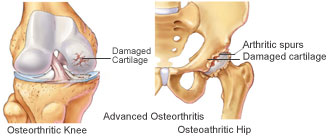There several varieties of arthritis depending upon the cause (etiology). The common varieties encountered in clinical practice are as follows:
1. Osteoarthritis or Osteoarthrosis (OA) – arthritis of old age
2. Rheumatoid arthritis (RA) – due to inflammation of synovial membrane
3. Other Inflammatory arthritis – e.g. ankylsoing spondylitis
4. Post-traumatic arthritis – due to fracture or dislocation of a joint,or ligament injury
5. Infective arthritis – due to infection e.g. tuberculosis (TB)
6. Gouty arthritis – due increased uric acid in the blood
7. Neuropathic Arthritis – seen in diabetic patients
Of these the commonest ones seen in clinical practice are Osteoarthritis(OA) and Rheumatoid arthritis(RA). These are discussed in some detail below.
Osteoarthritis / Osteoarthrosis (OA)
This is also known as degenerative type of arthritis. It occurs due to the wear and tear occurring in the joint due to advancing age. The cartilage covering the ends of bones wears out gradually causing the bone ends to come in contact with each other (bone rubbing on bone). This is seen as reduced gap in the joint on X-rays. The cartilage micro-fragments cause irritation of the joint which causes pain, swelling and stiffness in the joint. As the wear continues the limb develops various types of deformities (like bow legs, knock knees, bent knees etc)
Osteoarthritis usually occurs after the age of 50-55 years and is slightly more common in women than in men. Osteoarthritis can occur in any joint but it commonly affects the knee, hip, spine and small joints of the hand. Osteoarthritis usually tends to occur in one joint location at one time (one or both knees or hips). In the Indian population the commonest joint to be affected is the knee joint.
The exact cause of Osteoarthritis is not yet known. However there are some factors (known as risk factors) which predispose a person to develop osteoarthritis. These are: Obesity (Over weight), Heredity (family history of arthritis), Severe injury to a joint (fractures and dislocations, ligament and cartilage injuries) and Repetitive joint injuries (as in high demand athletes). Persons with one or more of these risk factors usually tend to develop arthritis at an earlier age.

Rheumatoid Arthritis (RA)
This is the commonest type of inflammatory arthritis seen in clinical practice. It is a type of auto-immune disease in which the body’s immune (defense) mechanism attacks the synovial membrane (inner lining of the joint) causing it to be inflamed. This inflammatory response leads to release of toxic chemicals which cause pain, swelling and stiffness of the joint. Over a period of time these chemicals also cause destruction of the joint cartilage. The loss of joint cartilage causes the bone ends to come in contact with each other. The eventual result is thus similar to that seen in osteoarthritis.
Rheumatoid arthritis is much more common in women than in men, and tends to present by the age of 25-30 years. Rheumatoid arthritis commonly affects the small joints of hands and feet, wrist, elbow and neck, though it can also involve larger joints like the shoulder, hip and knee. Typically it tends to affect multiple joints at the same time. Rheumatoid disease is known to affect other systems in the body like the heart, lungs, kidneys and eyes. Most patients with Rheumatoid Arthritis have positive RA factor in their blood. These patients are labeled as ‘sero-positive arthritis’. There other types of inflammatory arthritis (similar to RA) in whom the RA factor test is negative. These are labeled as ‘sero-negative arthritis’. Ankylosing spondylitis is a type of sero-negative arthritis.
End stage joint disease / Degenerative joint
When arthritis of any type persists a prolonged period of time, it eventually leads to destruction of the joint cartilage and structure. This is known as ‘end stage’ or ‘degenerative arthritis’. These changes in the structure of the joint are usually irreversible, and treatment with medications is usually not successful. Most of these patients may need surgical treatment for relief of their symptoms and correction of deformity.
